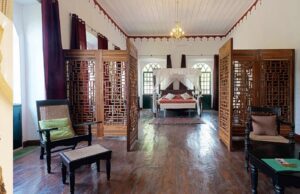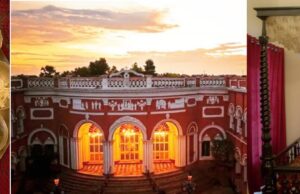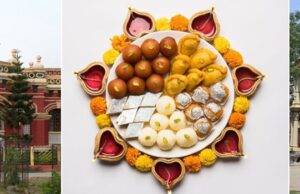
WoT's Hot
Destination Darjeeling: to seek out a Maharani. The fabled queen of hill stations has some crowning assets that continue to contribute to its heritage. The toy train, undoubtedly, is one of them, now that it has a fresh boost with the Unesco Heritage status that it has been accorded. This charming narrow gauge train which belongs to the Darjeeling Himalayan Railways has always foxed us about the sheer ingenuity of the steam engine pulling its little bogies around steep hillsides. As children, we often got off and walked along with the slow-paced train, but today, it is the tourists who freak out on the joy rides it offers. We joined the ranks of the tourists, too—for it is an experience not to be missed. Just for the record, the train dates back to the 1880s.
But tarry a while longer with us as we climb down the steep incline of Hill Cart Road to visit another heritage centurion institution—the Maharani Girls Higher Secondary School, Established 1908 and still continuing its educational journey. Darjeeling is renowned for some of the best schools in the country, and most of these trace their history back to the late nineteenth century. But my focus on this grand old lady of a township is a very personal one. To seek and find the “Maharani”. For this school was founded by my own great grandmother, Hemlata Sarkar.
The compulsions were many for this feisty, farsighted woman. Her father was Pandit Sivanath Shastri scholar, religious reformer, educator, writer and historian who had devoted the later part of his life to the cause of the Brahmo Samaj. Already a strong intellectual base for a young person. It is after her marriage to Dr Bepin Behari Sarkar, who was practicing in Kathmandu, and their shift to Darjeeling, that her crusading antennae for the cause of girls’ education saw her take up cudgels to right the situation. The established missionary schools denied Indian girls admission, amongst them Hemlata Sarkar’s own daughter. Rather than take her grouse to the “authorities”, she found a better way—opening a school of her own!
All very well, but her challenge was to convince people of orthodox families to send their girls to school. A modest and wonderful start was made, though with girls from six families in the prayer room of a house near Capitol Theatre. It belonged to the Cooch Behar estate. The medium of instruction—English! The room had to be vacated on Sundays, naturally for prayers to be held. The year, 1908.

And then there was no looking back. But yes, funding the whole institution was the challenge that she met head on. The current headmistress of the school, Purnima Roka puts the whole initial growth and funding scenario in perspective: “In 1909, the school was shifted to Oak Lodge on a monthly rent of Rs 150. In the 1930s, it was again shifted to the current premises (near the railway station) with the help of three Maharanis — Suniti Devi from Cooch Behar, Sucharu Devi from Mayurbhanj (Orissa) and Radharani Devi of Burdwan.” The best tribute that Hemlata Sarkar could pay to such largesse from these women of the royal families was to appropriately name it Maharani Girls’ High School. Today, it is a government sponsored school, with 450 students on its rolls, and continues to make its mark as the Maharani Girls Higher Secondary School.
Many members of my own family studied there and so many illustrious names leap out from the memories that they have shared with me. But it was not without effort on Hemlata’s part. She is said to have gone from door to door to request parents to send their wards to the school, and used her social contacts to persuade important families from Calcutta to repose their faith in the school by sending their daughters to Maharani Girls’, as we always referred to it.
A girl’s hostel was set up and the first boarder was the wife of Sudhi Ranjan Das, a former Chief Justice of India. Her sisters also studied there. My own grandmother, Suniti Devi, was the first matriculate to pass out from the school. She incidentally later became Hemlata Sarkar’s daughter-in-law. Her three daughters excelled themselves in their own fields, my mother, Tapati, the eldest, as a writer, and my middle aunt, Aditi, as a painter and the youngest, Sevati, who was to become the principal of Rani Birla College in her later years. My younger aunts studied at the school, and one of the educators whom the current teaching staff like to talk about is the well known author of children’s books Lila Mazumdar. They pointed out to me the beautiful heritage building where she taught way back in 1931 and it is said that her nephew Satyajit Ray spent some time as a child there too. Her teaching methods were rather unorthodox, for the classes that she loved to take were to do with storytelling, where the students imbibed the Ramayana and Mahabharata tales, or stories that she made up, and art classes where students would bring in objects from their natural surroundings and try to draw them. It didn’t gain her huge popularity, but definitely gave that something extra to the children.
Talking of other celebrated alumni, I quote from an ex-student Tapash Mukherjee who says: “Among other notable students who later adorned the lives of eminent personalities were Rani Mahalanabis, wife of renowned statistician Prasanta Mahalanabis………Sir Jadunath Sarkar’s daughter Roma Sarkar …….Other ex-students were Ila Hom and Meera Sanyal who later became befitting partners of late Amal Hom and Hironmoy Sanyal, noted litterateurs and social activists…The school was adjudged as one of the twelve best schools in undivided Bengal. Each annual prize distribution day used to be a great occasion as Governors, Majarajas and Maharanis used to preside over the ceremonies. Post-independence, those who visited the school were Dr K.N. Katju, C. Rajagopalachari and Dharam Vira.”
Following the death of her husband in 1918, Hemlata “plunged into harder work. In the early 1930s the school was shifted to the “German Sahib’s House” in its present location, near the railway station. The huge main block was constructed in 1938, and in 1943, Hemlata retired from her eventful life at the age of 75 years. Although the vacuum created by her death can never be filled but by her contribution in the education field would remain forever as an immortal figure. Having an overwhelming personality that always lovingly demanded and received obedience and discipline, Hemlata is cherished as an epitome of endurance, a visionary and a woman with impregnable spirit. She has left an indelible mark in the educational history of Darjeeling district”
Our earliest recollections are of landing up every summer to stay with cousins and aunts at North View, the charming cottage with its trademark wooden rafters, close to the Darjeeling Railway Station, where Hemlata Sarkar had started her life. We have over the years recreated in our mind’s eye a sparkling image of her in a white garad silk saree, wearing a long cream cloak over it and striding to school purposefully.
The visit in November turned out to be a fabulous bonding journey, greeted as I was by a group of enthusiastic teachers who could not imagine that the great-grand-daughter of their revered founder had actually come to the school. There’s miles to go before I sleep on the sweet memories, for I do have some promises to keep to them….
Destination Darjeeling: to seek out a Maharani. The fabled queen of hill stations has some crowning assets that continue to contribute to its heritage. The toy train, undoubtedly, is one of them, now that it has a fresh boost with the Unesco Heritage status that it has been accorded. This charming narrow gauge train
Other Articles in WANNAGO WOT
What to read next
Featured articles

Welcome Festive Season in Glam, Latin Quarters Launches new #PujoBling Collection with Monami Ghosh
by WOT












































